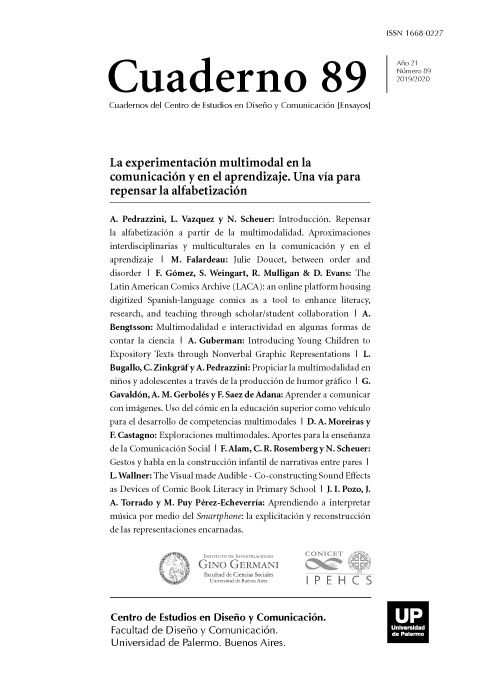Repensar la alfabetización a partir de la multimodalidad. Aproximaciones interdisciplinarias y multiculturales en la comunicación y en el aprendizaje
Abstract
In this volume of Cuadernos a close articulation among the fields of communication, visual and performative arts, and education is proposed. Our aim is to contribute to a broad conception of literacy, understood as a multimodal, situated process that develops and changes throughout the lifespan in the context of different areas of practice, with a strong participation of exploratory thought and experience. The ten works gathered in this volume -which are intentionally diverse- have been located in three interrelated axes. One of them focuses on experimentation, another one in multimodality and the third, on dialogical dynamics. These works explore and deepen some of these concepts by considering a variety of discursive manifestations such as comics, cartoons, music, drawing, conceptual definitions, exhibitions and scientific experimentations which have been deployed by children, adolescents and institutions.
References
Bazerman, C. (2014). Understanding the Lifelong Journey of Writing Development / Comprendiendo un viaje que dura toda la vida: la evolución de la escritura. Infancia y Aprendizaje/Journal for the Study of Education and Development, 36(4), 421-441.
Cope, B. y Kalantzis, M. (2009) “Multiliteracies”: New Literacies, New Learning. Pedagogies: An International Journal, 4(3), 164-195.
Jewitt, C. (2009). (Ed) The Routledge Hanbook of Multimedial Analysis. London: Routledge.
Kress, G. (2010). Multimodality: A social semiotic approach to contemporary communication. London: Routledge.
Lucariello, J. (1995). Mind, Culture, Person: Elements in a Cultural Psychology. Human Development, 38, 2-18.
New London Group. (1996). A Pedagogy of Multiliteracies: Designing Social Futures. Harvard Educational Review, 66(1), 60-92.
Los autores/as que publiquen en esta revista ceden los derechos de autor y de publicación a "Cuadernos del Centro de Estudios de Diseño y Comunicación", Aceptando el registro de su trabajo bajo una licencia de atribución de Creative Commons, que permite a terceros utilizar lo publicado siempre que de el crédito pertinente a los autores y a esta revista.


